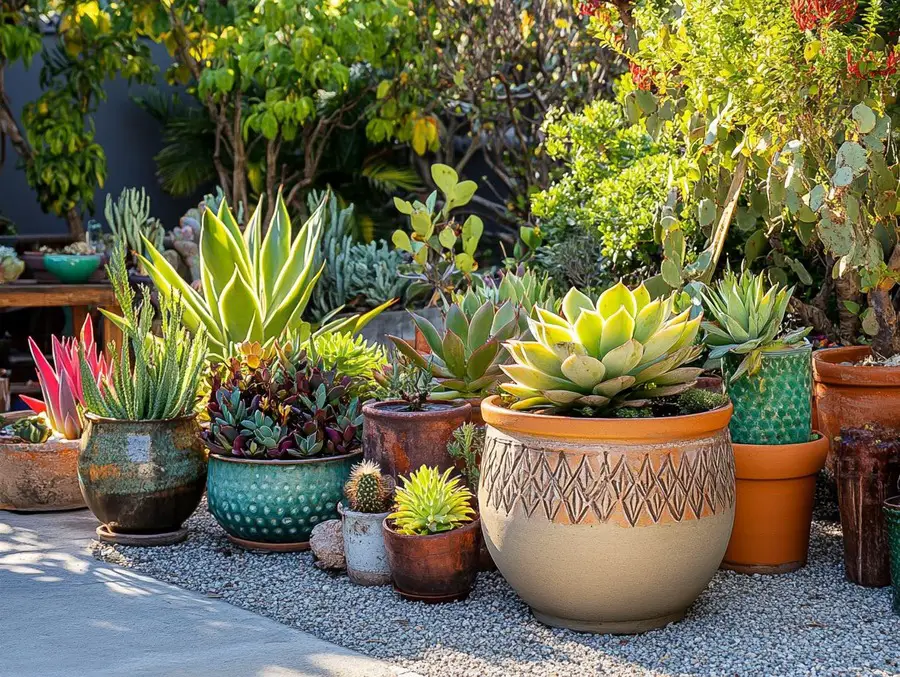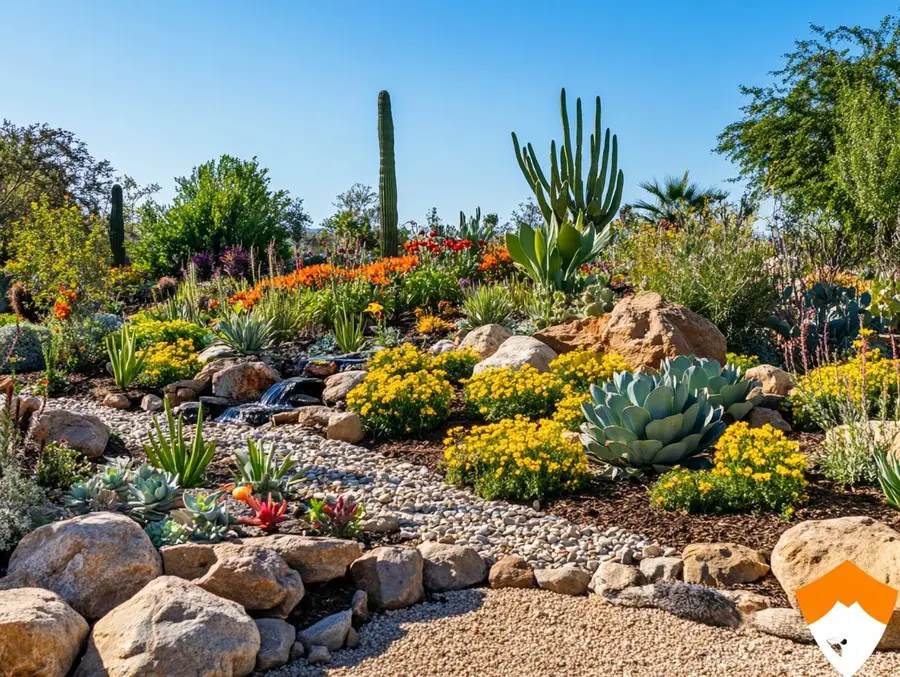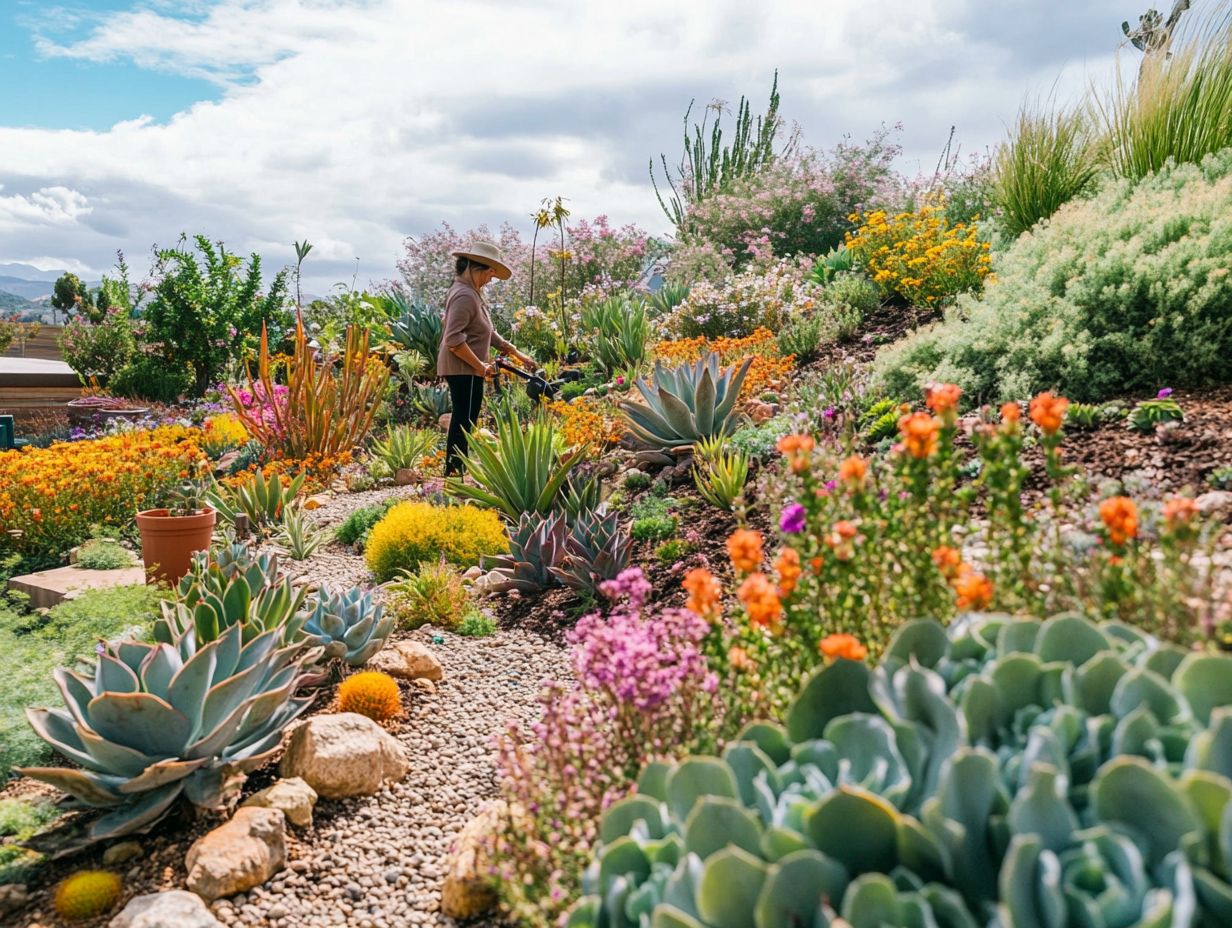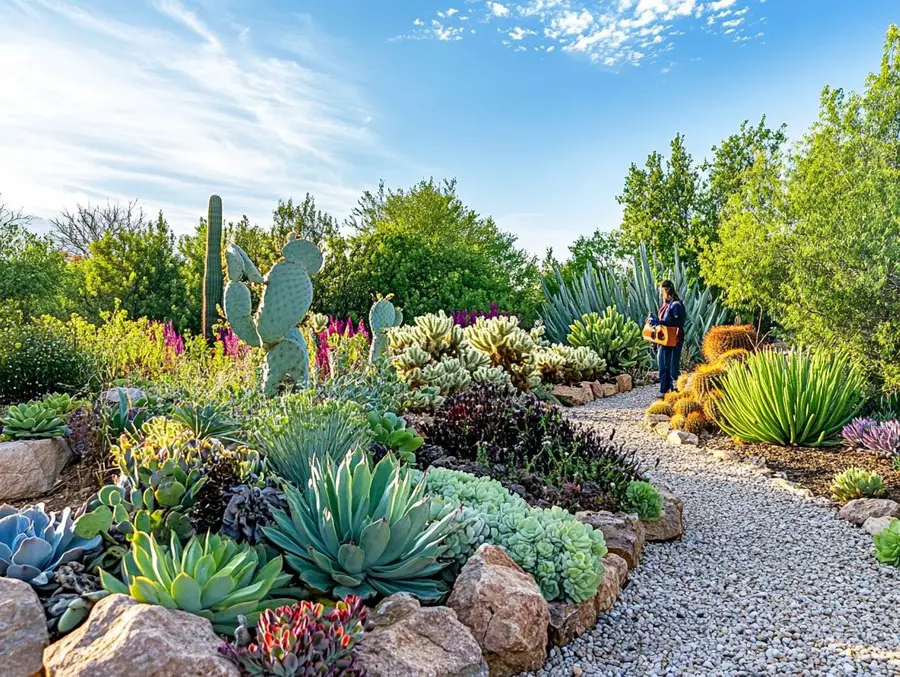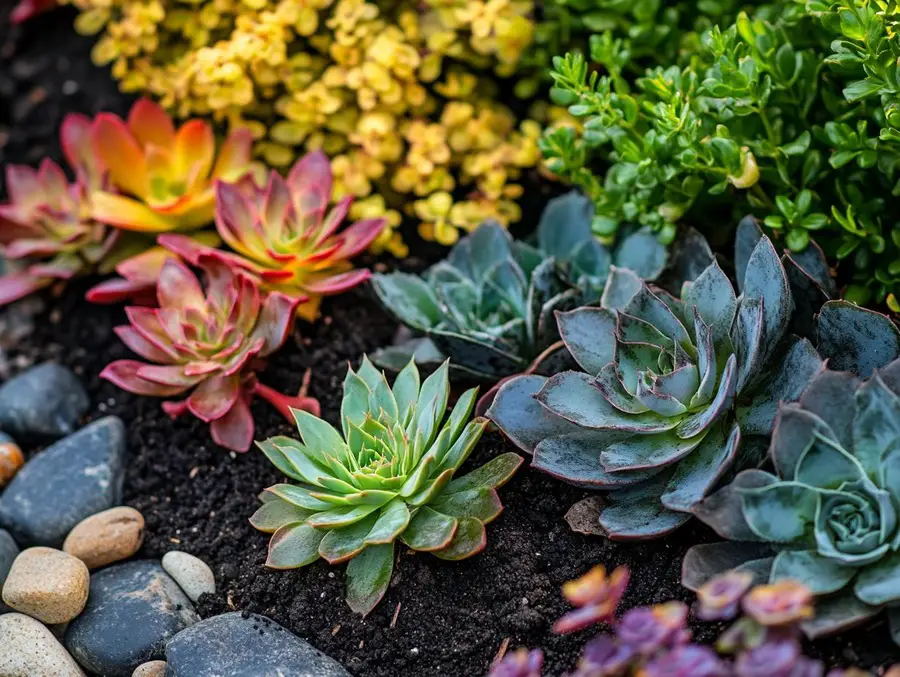We use affiliate links. If you purchase something using one of these links, we may receive compensation or commission.
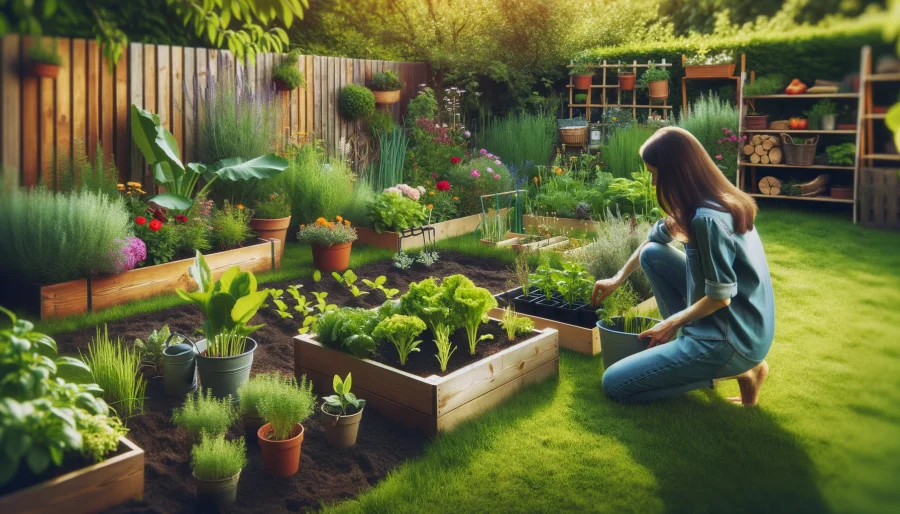
Uncover the joys of at-home gardening with our beginner-friendly guide. Learn easy tips and tricks to grow vibrant plants and veggies, no matter your space!
At Home Gardening for Beginners
Key Takeaways:
- At Home Gardening for Beginners involves starting a garden whether you have a backyard garden space, balcony, or windowsill.
- Use basic supplies like pots, soil, and seeds.
- It’s an easy and rewarding way to grow your plants, herbs, and vegetables, even with limited space.
- Start small, choose easy-to-grow plants, and enjoy the process of nurturing your garden.
At Home Gardening for Beginners: Easy Tips and Tricks
Howdy, fellow green thumbs, and aspiring gardeners! If you’ve ever dreamt of cultivating your own little patch of greenery, you’re in the right place.
Welcome to our beginner’s guide to at-home gardening, where we’ll show you that you don’t need a sprawling backyard to get your hands dirty and your heart happy.
Embrace Your Inner Gardener:
At-home gardening is all about making the most of the space you’ve got, whether it’s a sunny windowsill, a cozy balcony, or a modest patch of soil.
It’s a world where tiny seeds bloom into lush plants, and the fruits (or veggies) of your labor are quite literally, well, fruits and veggies!
Not to mention, it’s a fantastic way to spruce up your home, purify the air, and even shave a bit off your grocery bill.
Let’s Get Growing:
So, whether you’re looking to grow a jungle of jade plants or a balcony bursting with basil, we’ve got the tips and tricks to get you started.
Roll up your sleeves, and let’s dive into the fun and rewarding world of at-home gardening!
What Is At-Home Gardening?
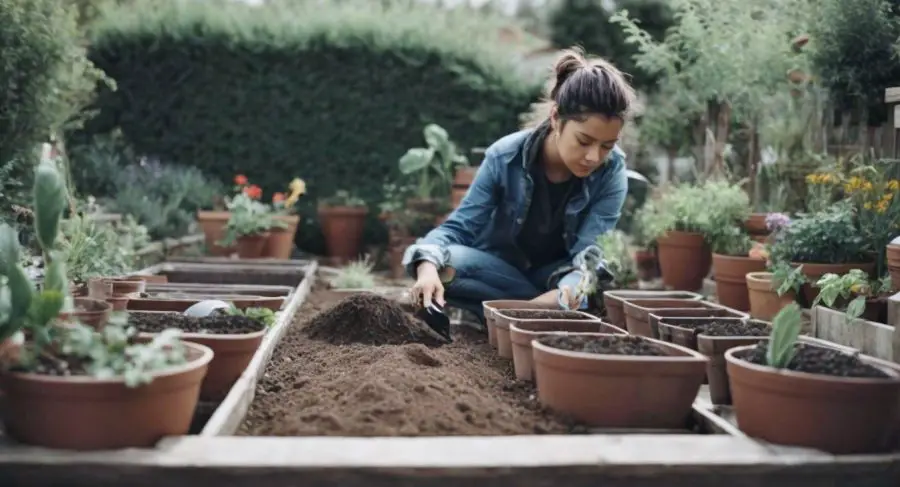
Hey there, fellow plant enthusiasts! Ever wondered what at-home gardening is all about? Well, it’s pretty simple.
At-home gardening is your ticket to creating a little slice of nature right where you live.
It doesn’t matter if you’ve got a sprawling backyard, a cozy balcony, or just a sunny windowsill – there’s a spot for you to get your green on.
A Garden for Every Nook:
- Backyard Bonanza: If you’re blessed with a backyard, the possibilities are endless. Plant a veggie patch, start a flower bed, or even try your hand at a mini fruit orchard.
- Balcony Beauties: No backyard? No worries! Balconies are perfect for container gardening. Imagine stepping out to a balcony brimming with juicy tomatoes, spicy peppers, or fragrant herbs.
- Windowsill Wonders: Tiny space? Big potential! A windowsill can be a cozy home for herbs like basil and cilantro or even some cheerful succulents.
From Corn to Hydroponics: My Gardening Saga:
Let me take you on a little trip down memory lane. As a kid, I was all about playing in the dirt. My first gardening adventure? Growing sweet corn in our backyard – and boy, did it grow!
Fast forward a few years, and I found myself running a truck farm in Washington State, with sweet corn as one of my star crops.
But here’s where it gets interesting. The quest to grow plants not suited to the Western Washington climate led me indoors – to the world of hydroponics and indoor gardening.
With the help of LED lights and hydroponic systems, I’ve been able to grow veggies, herbs, and houseplants that would otherwise be off-limits due to the local climate.
It’s been a journey of trial and error, but boy, has it been worth it!
Why Start an At-Home Garden?
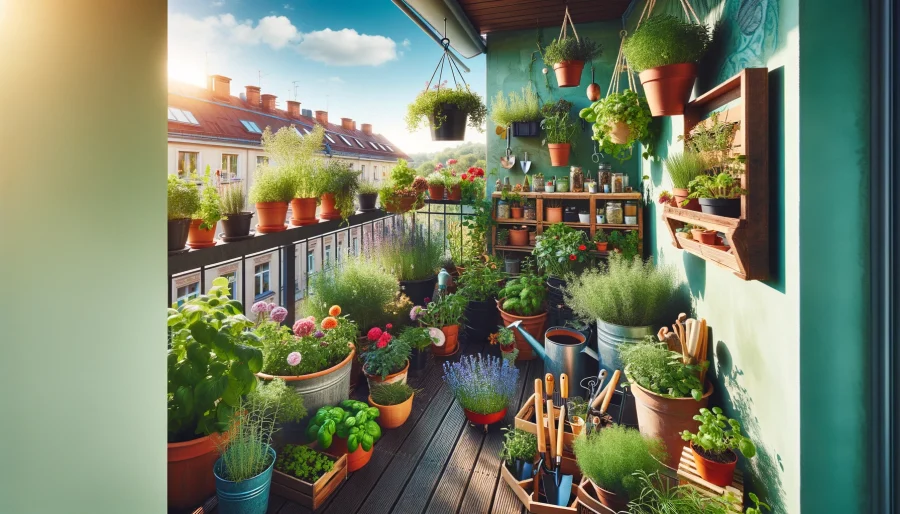
So, why should you dive into the world of at-home gardening?
Well, apart from the obvious bragging rights of being a plant parent, there are a whole bunch of reasons to get your hands dirty.
Grow Your Own Grub:
There’s something downright magical about watching a tiny seed transform into a bountiful plant.
The satisfaction of plucking a ripe tomato or snipping fresh basil right from your own garden? Priceless!
Plus, you get to play Mother Nature, deciding exactly what goes into your soil and onto your plate.
Health and Happiness:
Let’s talk health – and not just the “eat your veggies” kind.
Gardening is a workout for your body and your mind. It’s a way to soak up some vitamin D, breathe in fresh air, and even reduce stress.
And let’s not forget the nutritional punch of homegrown produce.
Those veggies aren’t just fresher; they’re packed with nutrients that supermarket finds might have lost along the way.
A Quirky Bonus:
Here’s a fun one for you – gardening is your ticket to becoming a time traveler!
Okay, not literally, but hear me out. By planting heirloom varieties, you’re growing the same flavors that your ancestors enjoyed.
It’s like taking a bite out of history!
Getting Started: What You Need
Ready to kickstart your at-home gardening adventure? First things first – let’s gather your gardening gear.
Don’t worry; you won’t need a shed full of tools to get going. Here’s a handy list to get you started:
Essential Supplies:
- Pots or Containers: Whether you’re going for classic clay pots, plastic pots, fabric pots, or repurposing old buckets, make sure they have drainage holes to keep your plants happy.
- Soil: A good quality potting mix is crucial. Look for one that’s well-draining and suited to the type of plants you want to grow. I prefer using coco coir myself.
- Seeds or Seedlings: Choose varieties that are well-suited to your space and climate. Starting with seedlings can give you a head start if you’re eager to see results.
- Watering Can or Hose: Consistent watering is key, so have a watering can or hose handy to keep your plants hydrated.
- Basic Gardening Tools: A trowel, pruning shears, and gloves are enough to get you started.
Here is a great set available on Amazon
Tips for Tool Selection:
- When choosing pots, think about the size and growth habits of your plants. Bigger plants or those that like to spread out will need more room.
- Invest in a quality potting mix. Your plants will thank you with lush growth and bountiful harvests.
- If you’re starting from seeds, look for ones with high germination rates. It’s like giving your plants a head start in life.
A Little Gardening Oops:
Let me share a little gardening oops from my early days. I once tried to grow tomatoes in a spot that barely got any sunlight.
Despite my best efforts, those poor tomato plants were as spindly as a noodle and didn’t produce a single fruit.
Lesson learned: always pay attention to your plants’ light needs!
Section 4: Planning Your Garden Space
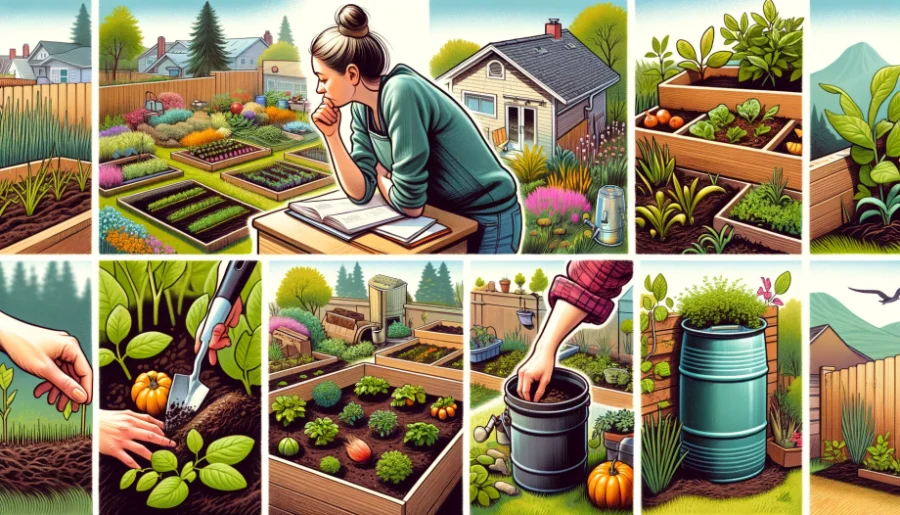
Before you start planting, let’s talk about setting the stage for your green babies.
The right location can make all the difference in your gardening success.
Picking the Perfect Spot:
- Sunlight: Most veggies and herbs crave sunlight – around 6 to 8 hours of direct light each day. So, find a spot that’s basking in those golden rays.
- Soil: If you’re planting directly in the ground, make sure the soil is well-draining and fertile. A simple soil test can reveal a lot about its pH and nutrient levels.
Solutions for Space and Light Challenges:
- Vertical Gardening: Got more wall than floor space? Go vertical! Use hanging planters, wall-mounted shelves, or trellises to grow upwards.
- Grow Lights: If natural light is scarce, consider investing in grow lights. They’re a game-changer for indoor gardening, helping you mimic the sun’s spectrum.
A Creative Twist for Small Spaces:
Here’s a little trick I’ve used in my own compact gardening adventures: repurpose a shoe organizer!
Hang it on a sunny wall, fill each pocket with soil, and voilà – you’ve got a space-saving vertical garden for herbs or small plants.
Gardening Without Limits: Creative Solutions for Small Spaces
Welcome to the world of limitless gardening, where space is just a detail, not a barrier.
Whether you’re working with a tiny patio, a cozy balcony, or just a sunny windowsill, we’ve got creative solutions to turn your small space into a green paradise.
Get ready to think outside the traditional garden plot and explore the endless possibilities of container, raised bed, and vertical gardening.
Let’s dive in and discover how you can grow your own lush oasis, no matter the size of your space!
Square Foot Gardening
Square Foot Gardening, for instance, involves dividing a square-foot garden into sections to maximize space utilization and simplify plant care.
It works for large or small gardens that want to increase productivity.
This method of gardening is extremely versatile allowing you to create beautiful vegetable gardens, herb gardens, or ornamental plant displays in even the smallest of spaces.
Container Gardening: The Art of Growing in Pots
Howdy, plant lovers! Ever heard of container gardening? It’s like having a portable garden you can move around to catch the sun or escape the rain.
Perfect for those of us with just a balcony or a windowsill to spare.
You can grow anything from juicy tomatoes to fragrant herbs, all in pots or planters.
The best part? You’re the boss of your soil and water. No more guessing what your plants need – you can tailor everything to keep them happy and thriving.
And if the sun decides to play hide-and-seek, just move your plants to a sunnier spot. Easy peasy!
Raised Bed Gardening: Elevating Your Green Game

Now, let’s talk about raised bed gardening. Imagine a garden bed that’s like a comfy raised mattress for your plants.
It’s all about giving your green babies the best soil and drainage, so they grow up strong and healthy.
You can fill these beds with the perfect soil mix, which means fewer battles with weeds and pests.
Plus, no more back-breaking bending to tend to your plants. Everything’s at a convenient height, making gardening a breeze.
And when it rains? No worries about your plants drowning – the elevated beds have got the drainage covered.
Vertical Gardening: Reaching New Heights
Vertical gardening is like giving your plants a ladder to the sky.
It’s a fantastic way to grow more in less space, especially if you’re in the city with just a tiny balcony or a small backyard.
Use trellises, walls, or even hanging baskets to let your plants climb up, up, and away!
This isn’t just about saving space; it’s about creating a living green wall that can cool your home and purify the air.
Plus, it’s a sight for sore eyes – a beautiful, lush display that’ll make your neighbors green with envy.
Choosing Your Plants
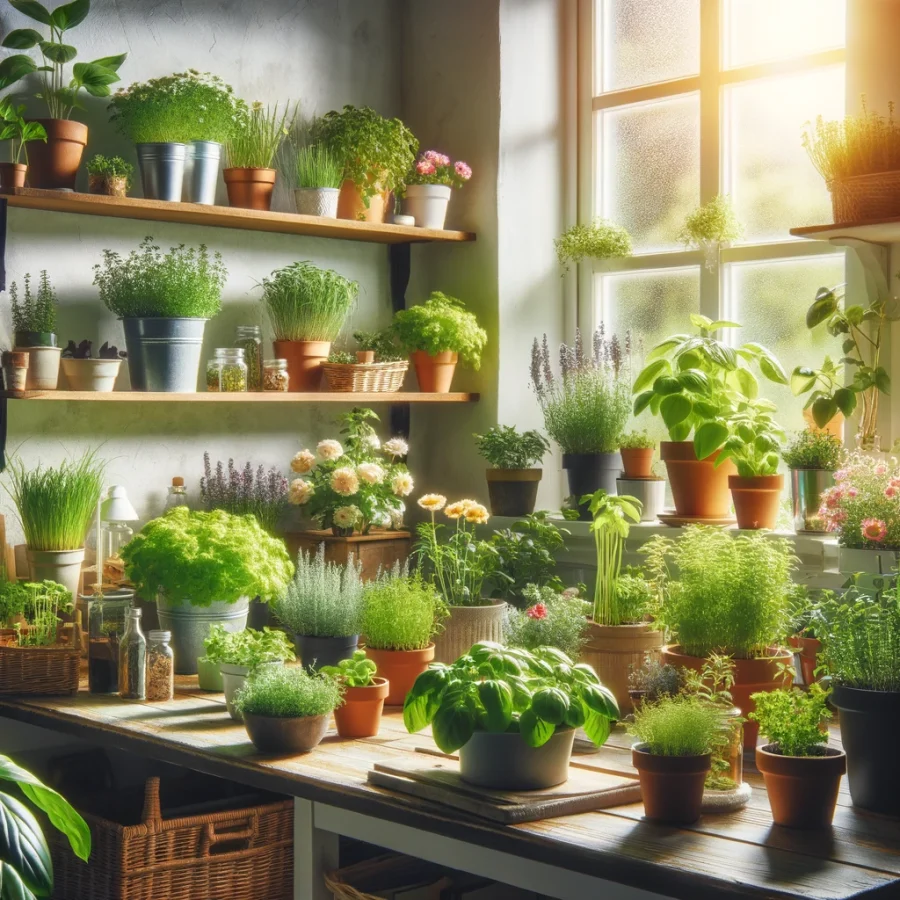 Picking the right plants is like selecting characters for a blockbuster movie – you want a cast that’s diverse, colorful, and full of life.
Picking the right plants is like selecting characters for a blockbuster movie – you want a cast that’s diverse, colorful, and full of life.
Whether you’re a veggie lover or a flower fanatic, there’s a plant out there just waiting for you to bring it home.
Easy-Peasy Plants for Beginners:
-
-
- Herbs: Start your herb garden with some classics like basil, mint, and parsley. They’re not just easy to grow; they’ll make your kitchen smell amazing too!
- Vegetables: If you’re itching for some homegrown veggies, cherry tomatoes, spinach, and bell peppers are great choices. They’re relatively low-maintenance and oh-so-tasty.
- Flowers: Brighten up your space with some cheerful marigolds, pansies, or nasturtiums. They’re pretty forgiving and will add a pop of color to your garden.
-
Tailoring Your Garden to Your Space and Climate:
-
-
- Size Matters: Consider how much space each plant needs to thrive. If you’re working with a small area, opt for compact varieties or vertical gardening solutions.
- Climate Check: Make sure your plant choices are well-suited to your local climate. Your garden center can help you find varieties that will flourish in your region.
-
My Go-To Green Buddy:
I’ve got a soft spot for basil. It’s not just easy to grow; it’s incredibly versatile in the kitchen.
Plus, there’s something about pinching off those fresh, fragrant leaves that just feels so rewarding.
One year, my basil plants turned into bushy green monsters, and I had more pesto than I knew what to do with. It was a delicious problem to have!
Planting and Maintenance
Alright, green thumbs, it’s time to get down and dirty – in the best way possible!
Planting your garden is just the beginning; keeping it happy and healthy is where the real magic happens.
Planting 101:
-
-
- Seeds: Start by planting your seeds in moist soil, following the depth and spacing instructions on the packet. Cover them gently and give them a good drink of water.
- Seedlings: If you’re starting with seedlings, carefully remove them from their containers and plant them at the same depth they were growing. Give them some water to help them settle in.
-
Garden TLC:
-
-
- Watering Wisely: Overwatering is like giving your plants too much love – it can be a bit smothering. Check the soil before watering; it should be moist, not soggy.
-
-
-
- Feeding Your Plants: Plants get hungry too! Use a balanced fertilizer to give them the nutrients they need. But remember, moderation is key – you don’t want to overfeed them.
-
A Humorous Heads-Up:
Here’s a little chuckle-worthy tip: singing to your plants doesn’t just make you the quirkiest neighbor on the block; it might just give them a boost!
I am not much of a singer but I think my plants rock out to Rock Music especially classic rock like Allman Brothers or Grateful Dead but they also enjoy blues especially Muddy Waters and Howlin Wolf.
Okay, the science is still out on that one, but hey, it can’t hurt, right? Just maybe save the opera for the shower.
Enjoying the Fruits of Your Labor
Congratulations, you’ve made it to the best part – reaping the rewards of your hard work!
Watching your garden flourish is a joy like no other, and it’s time to bask in the glow of your green accomplishments.
Celebrate Your Garden’s Growth:
-
-
- Take a moment to appreciate the journey. From those first tiny sprouts to lush plants laden with produce, you’ve nurtured life from the ground up. That’s something to be proud of!
-
Savoring Your Harvest:
-
-
- Get creative in the kitchen with your homegrown goodies. Fresh herbs can elevate any dish, while those juicy tomatoes are perfect for a vibrant salad or a homemade sauce.
- Don’t forget to share the love! Gifting friends and family with a basket of your garden’s bounty is a heartfelt way to spread the joy.
-
A Moment to Remember:
One of my most cherished gardening memories is the first time I harvested sweet potatoes. I can’t grow them outdoors but they thrived indoors.
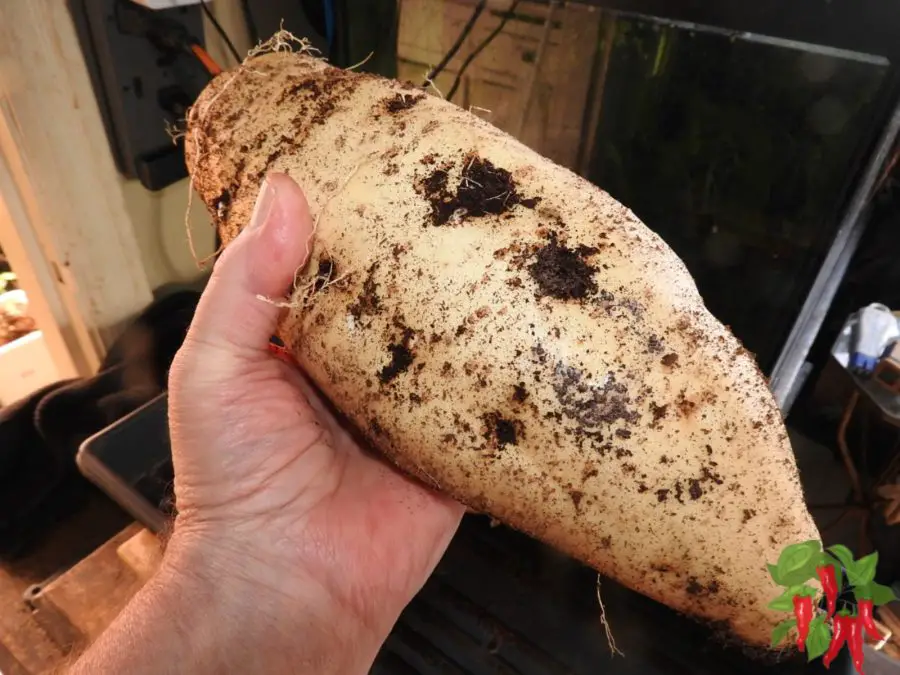
It was like holding a little (okay, not so little) treasure in my hands.
The look of surprise and delight on my friend’s faces was priceless. It was a reminder of the simple pleasures that gardening brings.
Here’s a video of them growing
At-Home Gardening FAQs:
Embarking on your gardening journey can be exciting, but it’s natural to have questions along the way.
Whether you’re wondering about the best plants to grow or how to keep your garden thriving, we’ve got you covered.
Here are some frequently asked questions by beginner gardeners:
Q. What is at home gardening for beginners?
A. At home gardening for beginners is the practice of growing plants, vegetables, or herbs in the comfort of your own home using basic gardening techniques and supplies.
It is a great way to add some greenery to your living space and enjoy the benefits of gardening without the need for a large outdoor garden.
Q. What are some benefits of home gardening for beginners?
A. Home gardening for beginners has many benefits, including reducing stress, improving air quality, providing fresh produce, and promoting a sense of accomplishment.
It is also a great form of exercise and can save money on grocery bills.
Q. What supplies do I need for at home gardening for beginners?
A. To start at home gardening, you will need basic supplies such as pots or planters, potting soil, seeds or seedlings, watering can or hose, and gardening tools like a trowel and pruners.
These can be easily found at any gardening or home improvement store.
Q. Do I need a lot of space for at home gardening for beginners?
A. No, at home gardening for beginners can be done in small spaces, such as a balcony, windowsill, or even on a kitchen counter.
You can use vertical gardening techniques or choose compact plants that do not take up much space.
Q. What are some easy plants to grow for home gardening beginners?
A. Some easy plants to grow for home gardening beginners are herbs like basil, mint, and parsley, leafy greens like lettuce and spinach, and flowers like marigolds and petunias.
These plants are relatively low maintenance and can be grown in pots or containers.
Q. How can I learn more about home gardening for beginners?
A. There are many resources available for learning about home gardening for beginners, such as books, online tutorials, and gardening classes.
You can also join online gardening communities or seek advice from experienced gardeners.
Learning by trial and error is also a great way to gain knowledge and experience in gardening.
Q. What are some easy vegetables to grow for beginners?
A. Start with veggies that are forgiving and productive. Some of the easiest include lettuce, green beans, radishes, tomatoes (by transplant), zucchini, peppers (by transplant), beets, carrots, leafy greens like chard, spinach, or kale, and peas.
Mix in some marigolds to discourage pests and add color to your garden.
Q. Where is the best place to buy plants?
A. While supermarkets offer a convenient option with shelves full of plants, many gardeners prefer purchasing from garden centers where the plants are often healthier and better cared for.
Ultimately, a plant’s success depends on how well it’s taken care of after bringing it home.
Q. Is mulch the same as compost?
A. No, they’re not the same. Mulch is used on top of the soil to prevent erosion, suppress weeds, and help retain moisture, while compost is mixed into the soil to add nutrients and improve soil structure.
Q. How can I keep my annuals thriving in a hanging basket all summer?
A. To keep your hanging baskets looking lush, water them daily to keep the soil moist, especially during hot summer months.
Regular feeding with a liquid fertilizer and grooming by removing spent blooms can also help maintain a vibrant display.
Q. Why is it important to prune your trees?
A. Pruning is essential for maintaining the health, appearance, and safety of your trees. It helps remove dead or diseased branches, encourages new growth, and can prevent potential hazards, such as falling branches.
Conclusion:
Well, folks, we’ve dug into the dirt, planted our seeds, and nurtured our gardens to life.
At-home gardening is a journey that’s full of surprises, challenges, and, most importantly, rewards.
It’s a way to connect with nature, enjoy fresher-than-fresh produce, and even add a splash of green to your living space.
So, whether you’re a seasoned gardener or a curious newbie, there’s never been a better time to start your own little patch of paradise.
Remember, every plant tells a story, and your garden is waiting to tell its own unique tale.
Keep it green, keep it growing, and most of all, have fun with it!
Read more: Backyard Gardening: A Comprehensive Guide
Here’s to the amazing adventure that is at-home gardening. Happy planting, everyone!
Gardening Resources:
Embarking on your gardening journey can be easier with the right resources at your fingertips.
Here are some useful links to help you get started, deepen your knowledge, and troubleshoot any issues you might encounter:
-
-
- Beginner’s Guides:
- Vegetable Gardening for Beginners – The Old Farmer’s Almanac provides a comprehensive guide to starting your first vegetable garden.
- Gardening Basics – Iowa State University Extension and Outreach offers a series of articles covering gardening basics.
- Plant Care Tips:
- Plant Care Guides – The National Gardening Association offers detailed care guides for a wide variety of plants.
- Houseplant Care Tips – Penn State Extension provides insights into caring for your indoor plants.
- Garden Planning Tools:
- Almanac Garden Planner – Plan your garden with this interactive tool from The Old Farmer’s Almanac.
- Vegetable Garden Planner – Mother Earth News offers a garden planner to help you design and manage your vegetable garden.
- Home Gardening Books

- Available on Amazon
- Beginner’s Guides:
-
Related Content
Visit my Amazon Influencer Page for videos and gardening products Grow Your Own Garden








